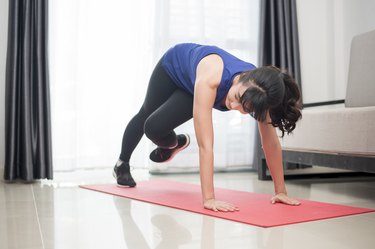
Whether you're calculating mountain climbers calories burned, burpees calories burned or running calories burned, you'll have to take several factors into consideration, beginning with exercise intensity and how often it's performed.
Tip
Factors such as form, frequency and intensity will contribute to how many calories you burn while doing mountain climbers.
Video of the Day
Mountain Climbers: Proper Technique
If you want to experience the full benefits to all the muscles mountain climbers work, including burning calories, it's important to maintain the proper form. The American Council on Exercise (ACE) lays out the steps for how to correctly execute mountain climbers:
Video of the Day
- Start in plank position, toes and hands on the mat, hands placed slightly in front of your shoulders.
- Shift your left foot forward, beneath your chest, while keeping the right leg behind you, toes tucked.
- Jump and alternate leg positions, so that the right foot is beneath your chest.
- Continue to repeat this movement, jumping back and forth, alternating sides.
You can also try a variation of mountain climbers called lunge mountain climbers, which, according to the ACE, are a hybrid exercise that combines forward lunges and mountain climbers. Begin in plank position, then bring the left foot to the outside of your left hand, switch legs so that the right foot is on the outside of the right hand. Alternate sides, and continue this movement for a given number of sets and repetitions.
Aerobic vs. Anaerobic Exercise
According to MedlinePlus, aerobic exercise is marked by slower, more prolonged physical activity, such as walking, while anaerobic exercise denotes shorter, more intense activities, like sprints.
A February 2017 paper in the Journal of Cardiology explains that, in aerobic exercise, your body supplies enough oxygen for the muscles to perform, while in anaerobic exercise, the muscles do not use oxygen to function. The oxygen demand is greater than its supply. One prime example of anaerobic exercise is high-intensity interval training (HIIT), which often includes sets of mountain climbers.
When it comes to burning calories, anaerobic exercise has been found to be more effective. In an article by the ACE, those who performed HIIT workouts burned more calories in less time compared to those who performed steady state cardio exercises.
With interval training, there's also greater metabolic efficiency and stimulation of muscle-building, fat-burning hormones, such as testosterone, growth hormone and insulin-like growth factors.
Calories Burned Doing Mountain Climbers
The more physical activity you do, the more calories your body burns. Burning calories through exercise, combined with reducing the number of calories you eat, creates what's called a calorie deficit, per the Centers for Disease Control and Prevention (CDC). Weight loss through physical activity can depend on the amount you do and the level of intensity.
The amount of mountain climbers calories burned should fall within a range of 450 to 500 calories per hour for a 130-pound person, according to Wisconsin's Department of Health Services's estimate for vigorous calisthenics. For a 155-pound person, that estimate is 550 to 600 calories, and for a 190-pound person, it's closer to 700 calories burned per hour.
According to the CDC, everybody has different diet and exercise needs, and there are other factors than can affect weight gain besides diet and physical activity. Genetics, for instance, can play a role in how rapidly you gain weight.
Certain drugs, such as steroids and some antidepressants, and your environment are also factors that can lead to quicker gains in body fat. Moreover, sleep and stress levels should be regulated for a healthy metabolism.
Correction: An earlier version of this story incorrectly attributed the number of calories burned doing mountain climbers. We appreciate readers who bring errors like these to our attention! If you spot something in one of our articles, please reach out: [email protected].